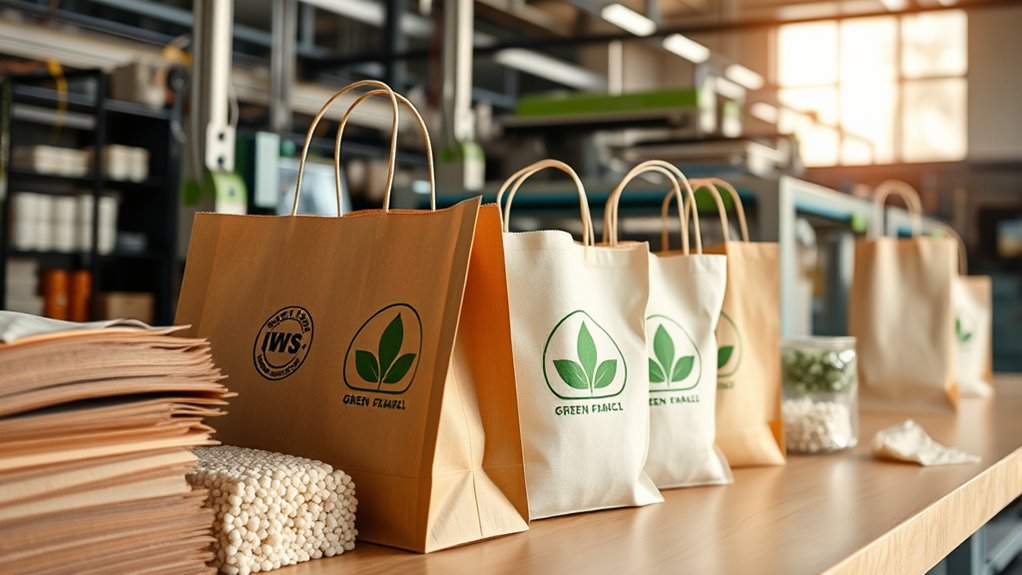Sustainable packaging in bag manufacturing involves using eco-friendly materials like biodegradable plastics, recycled paper, and natural fibers, which break down faster and reduce environmental impact. Recycling initiatives and take-back programs help manage used bags and promote a circular economy. Industry standards ensure responsible practices that build consumer trust and support environmental goals. As the industry advances with innovations and stakeholder support, you’ll discover how these efforts are shaping a greener future for bag production.
Key Takeaways
- Companies are adopting eco-friendly materials like bioplastics, recycled paper, and natural fibers to replace traditional plastics.
- Recycling initiatives, take-back programs, and partnerships with recycling centers promote waste reduction and resource conservation.
- Industry standards ensure responsible practices, fostering consumer trust and supporting environmental accountability.
- Stakeholders and consumers advocate for sustainable brands, driving market demand and innovation in greener packaging solutions.
- Despite challenges in scalability and material availability, ongoing industry progress emphasizes sustainability and environmental impact reduction.

Are sustainable packaging practices truly making a difference in the bag manufacturing industry? It’s a question many ask as the push for eco-conscious solutions intensifies. The answer is a definite yes, especially when you look at how companies are integrating recycling initiatives and eco-friendly materials into their production processes. Recycling initiatives have become a cornerstone of sustainable packaging because they reduce waste and conserve resources. Manufacturers now design bags that are easier to recycle, implement take-back programs, and partner with recycling centers to guarantee used bags don’t end up in landfills. This approach not only minimizes environmental impact but also resonates with eco-aware consumers who want to support responsible brands. When you choose manufacturers committed to recycling initiatives, you’re supporting a circular economy—where materials are reused rather than discarded. This shift is essential because it lessens the demand for virgin resources and cuts down on pollution caused by manufacturing and waste disposal.
Alongside recycling initiatives, the adoption of eco-friendly materials plays a critical role in transforming packaging practices. Traditional plastics, which have dominated the industry for decades, are now being replaced or supplemented with biodegradable, compostable, and renewable alternatives. These eco-friendly materials include plant-based bioplastics, recycled paper, and natural fibers that break down more quickly and safely in the environment. By choosing bags made from such materials, you’re actively reducing your carbon footprint and promoting sustainability. Many companies now develop innovative packaging options that combine durability with environmental responsibility. For instance, biodegradable bags that decompose within months after disposal are increasingly common, offering a practical alternative to single-use plastics. This shift also encourages consumers to think twice before tossing away packaging and supports broader efforts to reduce plastic pollution. Additionally, the industry’s focus on regulatory oversight helps ensure that sustainable practices meet safety and quality standards, fostering consumer trust and environmental accountability.
Implementing these sustainable practices isn’t just about following trends; it’s about making tangible improvements. In your role—whether as a consumer, retailer, or industry stakeholder—you can advocate for and support brands that prioritize recycling initiatives and eco-friendly materials. Doing so helps foster a market where sustainability is the norm rather than the exception. It also pushes manufacturers to innovate further, creating smarter, greener solutions for packaging needs. While challenges remain, such as guaranteeing the availability of eco-friendly materials at scale or creating effective recycling systems, the industry is undeniably moving in a more sustainable direction. Every step toward recycling initiatives and the use of eco-friendly materials signifies progress, making a real difference in reducing environmental impact and shaping a more sustainable future for bag manufacturing.
Frequently Asked Questions
How Do Sustainable Packaging Costs Compare to Traditional Options?
Sustainable packaging costs are generally higher than traditional options, but a thorough cost analysis shows potential long-term savings. You’ll find that eco-friendly materials often come with a higher price comparison upfront, but they can reduce waste disposal costs and improve brand reputation. Although initial expenses are higher, investing in sustainable packaging can lead to cost efficiencies over time, making it a smart choice for environmentally conscious businesses.
What Certifications Should Sustainable Packaging Providers Have?
You should look for sustainable packaging providers with eco label standards like FSC, PEFC, or B Corp, ensuring they meet rigorous certification requirements. These certifications verify that their materials are environmentally friendly, ethically sourced, and produced responsibly. By choosing providers with these credentials, you guarantee your packaging aligns with sustainability goals, reduces environmental impact, and demonstrates your commitment to eco-conscious practices. Always verify the validity of their certifications before partnering.
How Does Sustainable Packaging Affect Product Shelf Life?
Sustainable packaging can positively impact your product’s shelf life by using biodegradable materials that protect against moisture, oxygen, and contaminants. These eco-friendly options maintain freshness while reducing environmental impact. However, choose biodegradable materials carefully, as some may have a shorter shelf life compared to traditional packaging. Proper sealing and barrier properties are essential to guarantee your product stays fresh, regardless of the eco-friendly packaging you select.
Are There Any Limitations in Design Flexibility With Eco-Friendly Materials?
You might find that eco-friendly materials impose some design constraints because they offer fewer material options and have specific limitations. These design constraints can restrict flexibility, making it harder to customize shapes and sizes. However, you can still innovate within those material options by exploring alternative sustainable materials or adjusting your design approach. Ultimately, balancing sustainability with design flexibility requires creativity and careful selection of eco-friendly packaging solutions.
What Are the Future Trends in Sustainable Bag Manufacturing?
You’ll see a shift toward innovative materials and a more transparent supply chain in sustainable bag manufacturing. Studies show that 65% of consumers prefer eco-friendly packaging, prompting brands to adopt biodegradable and recycled materials. Future trends include integrating smart technology and enhancing supply chain sustainability to reduce carbon footprints. By embracing these advancements, you can stay ahead, improve environmental impact, and meet growing consumer demand for responsible packaging solutions.
Conclusion
As you explore sustainable packaging practices in bag manufacturing, one thing becomes clear: the future holds unexpected innovations that could redefine industry standards. Will these new materials and strategies fully replace traditional methods? The journey toward eco-friendly packaging is far from over, and the next breakthrough could be just around the corner. Stay tuned—you won’t want to miss what’s coming next in this evolving story of sustainability.









